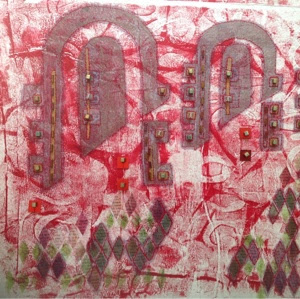If you pop by the blog from time to time, you might know that I have a bit of a complicated life.
I 'live' in Hampshire.
But my 'studio' (the back room that I like to think of as my studio, at least) is in Northamptonshire.
Dear reader, Northamptonshire is the forgotten county! But I won't wax too lyrical about that now. Instead a bit of history.
Reading the page from the Cowper and Newton Museum in Olney, I learn that lace was probably made in the Eastern Counties (Buckinghamshire, Bedfordshire, Northamptonshire) prior to 1563. This was, and apparently still is, a flax growing area (though I cannot say that I have any noted any growing).
The big influences arrived when refugees arrived from the continent during the 16th Century. The first wave of lace makers came in 1563 to 1568. These were Flemish Protestants who left the area around Mechelen (Mechlin / Malines) when Philip II introduced the Inquisition to the Low Countries:
1563: Twenty-five recent widows, makers of bone lace, settled in Dover, Kent;
400 settled in Sandwich, Kent;
But in 1567 it is estimated that 100,000 left Flanders when the Duke of Alva became head of the Spanish Catholic Army. Most of that number came to England.
Second wave of lacemakers, many from Lille, left in 1572 after The Massacre of the Feast of Saint Bartholomew (about which I know nothing, but a bit of googling calls). Exactly how many is not known but many apparently hundreds came to Buckinghamshire and Northamptonshire.
Now I sort of knew this, as the centre of the lace industry was in Olney (which is actually in Bedfordshire, but is right on the border with Northamptonshire) but what I did not know was quite how extensive the industry was.
Now my 'home from home' village (Deanshanger - well a suburb of Milton Keynes really) is in South Northants and between MK and Buckingham. Recently it has a village history day - so I popped along.
And it was fascinating. In the late 1800s there were over 50 people living here who were registered as lace makers. There was even a Bobbin Maker - Jesse and his son James Compton .
When you dig around on the internet you can see that the influence of the lace industry lingers on. There are still lace makers in Olney and bobbin makers in Wilmslow.
And these people were trying it.
I wasn't tempted. I have too many projects on the go, and don't think I have the patience!








I didn't know that lace making had such a long history, let alone that there were still people practicing it. Apparently there's a substantial group of people in Belgium who keep lace making alive too: http://www.stowawaymag.com/2012/05/living-art-lacemaking-in-bruges/
ReplyDeleteI don't blame you for avoiding a lace project right now, though. It looks really complicated, but I'm sure it would feel great to finish a lace project.
hello Nyssa - thanks for stopping by and leaving a comment.
DeleteLace was very big in the Olney area but I had no idea it was in my little corner of Northamptonshire - about 15 miles west of Olney.
There is still an Olney Lacemaking group who keep the skills alive.
It is fascinating stuff, but I don't think I would have the patience.
It seems that most of my female ancestors who lived in Greens Norton, Northamptonshire and belonged to the Abel family were professional lace makers and seemed to be the main breadwinners! This is so from at least 1680s (which is as far back as I have verified as yet) until my Great great grandmother, Maria Abel who was born in the early C19th. (I have got the exact details of dates and residences if you are interested)
ReplyDelete